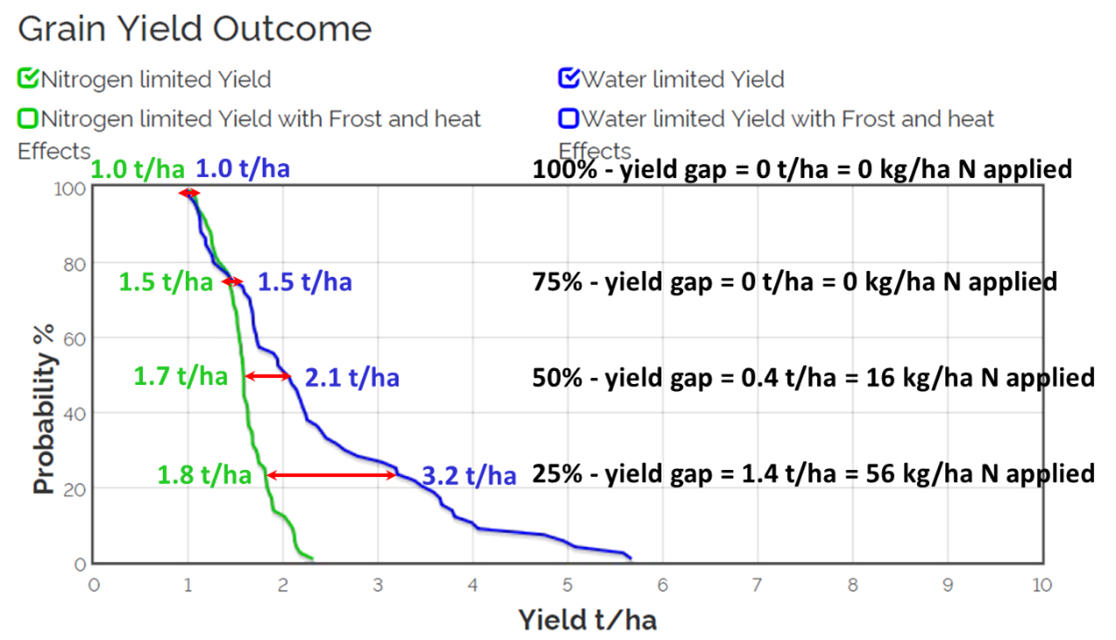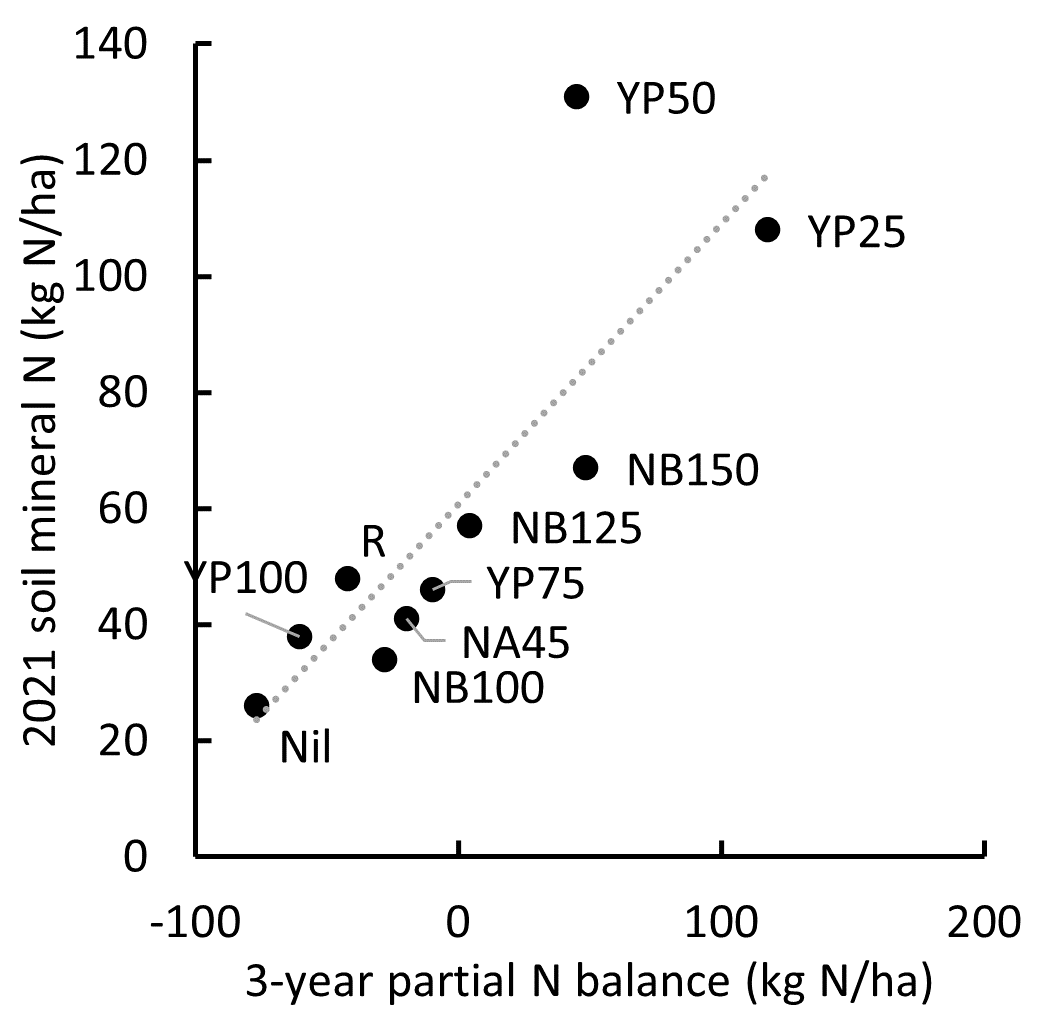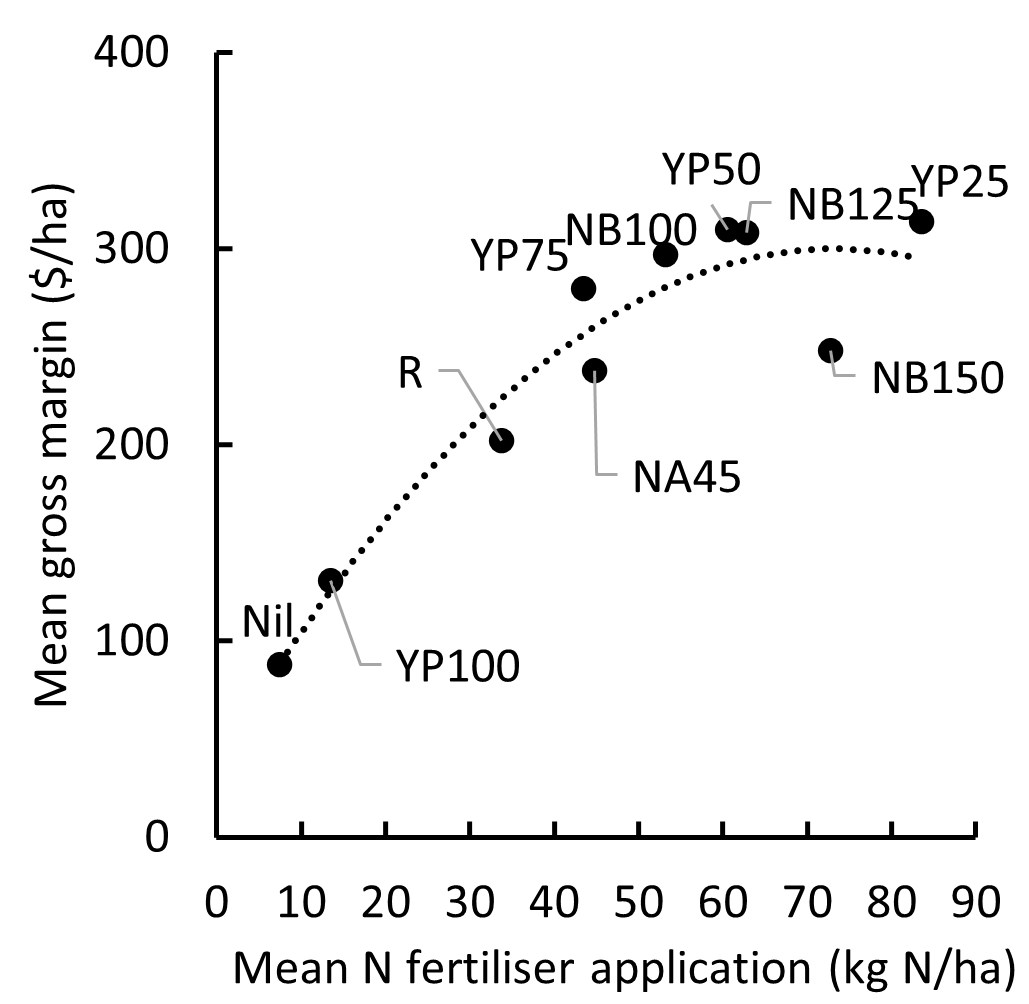Managing N fertiliser to profitably close yield gaps
Author: James Hunt (University of Melbourne) and James Murray & Kate Maddern (BCG) | Date: 23 Feb 2022
Take home messages
- Making fertiliser N decisions based on Yield Prophet® Lite or an environmentally appropriate N bank target maximises profit, slows soil organic N decline and prevents accumulation of excessive mineral N.
- N decisions based on 50% Yield Prophet® probability or 125 kg/ha N bank strategy apply more N (60-80 kg/ha) are over $100/ha per year more profitable than the district average N rate (21-30 kg/ha N).
- The most profitable strategies all have neutral to positive N balances (more N applied in fertiliser than removed in grain) indicating soil organic N is not being mined.
- High urea prices anticipated for 2022 will reduce profit and optimal N rates. Growers can offset this by using alternative sources of N e.g. planting a higher area of legumes (grain, hay, pasture, brown manure) and using organic wastes (manure, compost, biosolids) where available and cost effective.
Background
Australian wheat yields are only half what they could be for the rainfall received (Hochmanet al. 2017). Nitrogen (N) deficiency is the biggest factor contributing to this yield gap. This is also likely to be true for other non-legume crops (barley, canola and oats) and this reduces farm profitability. Alleviating N deficiency would increase national wheat yields by 40% (Hochman and Horan 2018).
On farms with no legume pastures, most of the crop N supply must come from N fertiliser. Grain legumes do not provide enough N to support yield of subsequent crops at the intensity at which they are currently grown. N fertiliser is a costly input and use of it increases cost of production and value-at-risk for growers. Growers fear that over-fertilisation will result in ‘haying off’, which reduces both yield and quality. There is also concern that overapplied fertiliser not used by crops is lost to the environment by leaching, volatilisation and denitrification. Consequently, efforts are made to match N fertiliser inputs to seasonal yield potential. This is difficult in southern Australia due to uncertainty of seasonal forecasts for rainfall at the sowing. The difficulty in matching N supply to crop demand and a tendency for growers to be conservative in their N inputs is the cause of the large proportion of the yield gap.
In 2018, BCG and La Trobe University commenced a multi-year field experiment to evaluate the potential for different N management systems to profitably close the yield gap and slow organic matter decline. The year 2021 was the fourth season of the experiment.
Aim
To evaluate different N management systems designed to profitably close the yield gap due to N deficiency and slow soil organic matter decline.
Paddock details
Paddock details | |
Location: Curyo, Victoria | |
Crop year rainfall (Nov-Oct): | 2018: 200 mm |
2019: 368 mm | |
2020: 358 mm | |
2021: 241 mm | |
Soil type: | Sandy loam top-soil with clay content and calcium carbonate increasing with depth |
Paddock history: | 2017: Lentil |
Trial details
Crop type/s: | 2018: wheat cv. ScepterA |
2019: canola cv. Hyola 350 TT | |
2020: wheat cv. ScepterA | |
2021: barley cv. Spartacus CLA | |
Treatments: | Refer to Table 1 |
Seeding equipment: | Knife points, press wheels, 30cm row spacing |
Sowing date: | 2018: 14 May |
2019: 29 April | |
2020: 16 May | |
2021: 14 May | |
Replicates: | Four |
Harvest date: | 2018: 15 November |
2019: 15 November | |
2020: 21 November | |
2021: 25 November |
Trial inputs
N fertiliser: | Refer to Table 2 for nitrogen fertiliser applications in 2020 and 2020 BCG Season Research Results (pages 122 to 128) for results from 2018, 2019 and 2020. All nitrogen fertiliser has been top-dressed as a single application of urea during winter. |
Starter fertiliser: | 2018: Urea @ 35kg/ha at sowing (host grower management) |
2019: Granulock® Z @ 60 kg/ha at sowing | |
2020: Granulock Z @ 60 kg/ha at sowing | |
2021: Granulock Z @ 60 kg/ha + triple superphosphate @ 35 kg/ha at sowing |
The experiment was kept free of weeds and disease as per current best practice management.
Method
A multi-year experiment using a randomised complete block design was established in 2018 to evaluate the performance of different N management systems. There were four different systems being tested:
- Matching N fertiliser to seasonal yield potential (Yield Prophet® and Yield Prophet Lite, YP)
- Maintaining a base level of fertility using N fertiliser (N banks, NB)
- Replacing the amount of N removed in grain each year with fertiliser in the next season (replacement)
- Applying national average N fertiliser rate (45 kg/ha) each season (national average, NA)
All systems were compared to a nil control to which only starter fertiliser was applied (7kg N/ha per year). (7 kg N/ha per year). Within the Yield Prophet® and N bank systems, there were additional treatments targeting different yield potentials (Table 1). In the Yield Prophet treatment prior to 2021, water limited potential yield was determined at different levels of probability and the amount of N required to achieve these yields applied assuming a requirement of 40 kg N /ha N per t wheat yield and 80 kg N /ha per t canola yield (Figure 1). From 2021 onward, Yield Prophet® Lite was used in a similar way. For the N bank treatments, there were different target levels of N fertility (N banks). N fertiliser rate in these treatments were calculated as the N bank value minus soil profile mineral N (kg/ha) measured prior to sowing.
Gross margins were calculated for the four years of the experiment using values from the 2021 SAGIT Gross Margin Guide assuming medium rainfall and 5 year average prices (SAGIT 2021).
Table 1: Nitrogen management systems and treatments used in the experiments.
System | Treatment | Description |
|---|---|---|
Nil | Nil | No nitrogen applied other than in starter fertiliser |
Replacement | - | Amount of N removed in grain applied as fertiliser N in the following season |
National average | - | National average N fertiliser (45 kg/ha N) applied each season (Angus & Grace, 2017) |
Nitrogen banks (kg/ha N) | 100 | Soil mineral N + fertiliser = 100 kg/ha N |
125 | Soil mineral N + fertiliser = 125 kg/ha N | |
150 | Soil mineral N + fertiliser = 150 kg/ha N | |
Yield Prophet probabilities | 100% | Yield with lowest yielding season finish on record (decile 1 in Yield Prophet Lite) |
75% | Yield with lower yielding quartile season finish (decile 2-3 in Yield Prophet Lite) | |
50% | Yield with median season finish (decile 4-7 in Yield Prophet Lite) | |
25% | Yield with higher yielding quartile season finish (decile 8-9 in Yield Prophet Lite) |

Figure 1. An example from 2018 of how Yield Prophet is used to determine water limited potential yield given probabilities of different season yield outcomes, and how this is used to calculate a yield gap and N fertiliser rate required to close the yield gap.
Results and interpretation
2018-2020 results
Please see 2020 BCG Season Research Results (pages 122-129) for results from the 2018- 2020 growing seasons.
2021 Results
After 2 years of the experiment, there were large differences between treatments in soil mineral N measured prior to sowing in 2021 (Table 2). There was a strong positive relationship between 3-year N balance (fertiliser applied minus N removed in grain in 2018-2020) and soil mineral N measured (Figure 2). On average, 76% of fertiliser N applied 2018-2020 that exceeded grain removal was available as mineral N prior to sowing in 2021. This is consistent with N recovery measured in 2019 and 2020. Yield Prophet 50% and 25% treatments had the highest mineral N reflecting very high fertiliser N applications made in 2020. N in these treatments would have been at risk of larger losses over summer compared to treatments with less mineral N. All N bank treatments had lower mineral N in 2021.
Table 2. Soil mineral N measured prior to sowing, top-dressed N, crop N supply, barley grain yield, protein and gross margin for different treatments in the experiment in 2021.
System | Treatment | Soil mineral N (kg/ha) | Top dressed N (kg/ha) | N supply (kg/ha) | Yield (t/ha) | Protein | Gross margin ($/ha) |
|---|---|---|---|---|---|---|---|
Nil | Nil | 26 | 0 | 33 | 1.1 | 10.0 | -$113 |
Replacement | - | 48 | 50 | 105 | 2.3 | 10.7 | $77 |
National average | - | 41 | 45 | 93 | 2.2 | 10.4 | $62 |
Nitrogen banks (kg/ha N) | 100 | 34 | 59 | 100 | 2.3 | 10.8 | $64 |
125 | 57 | 61 | 125 | 2.4 | 11.6 | $83 | |
150 | 67 | 76 | 150 | 2.6 | 12.2 | $105 | |
Yield Prophet probability | 100% | 38 | 0 | 45 | 1.1 | 10.3 | -$113 |
75% | 46 | 0 | 53 | 1.7 | 10.7 | $17 | |
50% | 131 | 0 | 138 | 2.1 | 11.0 | $104 | |
25% | 108 | 8 | 123 | 2.4 | 12.2 | $158 | |
Sig. diff. LSD (P=0.05) | <0.001 24 | - - | <0.001 20 | <0.001 0.2 | <0.001 0.7 | - - |

Figure 2. The relationship between 3-year N balance (2018-2020) and soil mineral N measured prior to sowing in 2021. The linear regression is fitted by least-squares regression to the positive N balance values only and is of the form y = 0.48x + 60.60, R² = 0.69.
Despite the relatively dry growing season (only 129 mm rain or decile 1 up to 28 September), grain yield, protein and gross margin increased relative to N supply (Table 2). The highest yielding treatment was the 150 kg/ha N bank treatment which had the most fertiliser N in 2021, but the most profitable treatment was the Yield Prophet 25% treatment which had high rates of fertiliser in 2020 (128kg N/ha), a lot of which carried over as mineral N in 2021 and thus only 8 kg N/ha fertiliser N was applied.
4-year averages
Comparison of the different systems over the four years of the experiment shows that the Yield Prophet 50% and N bank 125 kg/ha N treatments were most profitable, with several other treatments achieving similar levels of profit. All these treatments, on average, had more fertiliser N than the district average of 21—30 kg N/ha (Norton 2016) or national average of 45 kg/ha (Figure 3). Assuming the district average N application is 30kg N/ha, the non-linear function suggests that the Yield Prophet 50% and N bank 125 kg/ha treatments, on average, returned ~$100/ha per year more profit than the district average.
The two most profitable treatments also had a neutral to slightly positive 4-year partial N balance (N applied in fertiliser minus N offtake in grain, Figure 4), indicating that soil organic N is not being mined. This contrasts to the Nil control with a 4-year N balance of -89 kg/ha N which, based on the soil C:N ratio at the site of 9.7, suggests ~863 kg/ha of soil organic carbon was lost during the experiment.

Figure 3. The relationship between mean 4-year fertiliser application and mean 4-year gross margin for the different treatments. The quadratic function fitted by least-squares regression is of the form y = -0.05x2 + 7.16x + 37.51, R² = 0.90.

Figure 4. The relationship between 4-year partial N balance and 4-year mean gross margin for the different treatments. The quadratic function fitted by least-squares regression is of the form y = -0.01x2 + 1.05x + 282.74, R² = 0.84.
The grains industry is understandably concerned about what high urea prices will mean for farm profitability and N strategies in 2022. Figure 5 shows the 4-year average N rate and gross margin for this experiment, assuming either a urea price of $550/t (as used in Figure 3) or $1100/t with all other costs and prices held constant, profit will be reduced at high urea prices and the most profitable urea rate reduces in this example from 73kg N/ha to 61kg N/ha.

Figure 5. The relationship between mean 4-year fertiliser application and mean 4-year gross margin for the different treatments assuming a urea price of either $550/t or $1100/t. The quadratic functions fitted by least-squares regression are of the form y = -0.05x2 + 7.16x + 37.51, R² = 0.90 for $550/t and y = -0.05x2 + 6.61x + 31.64, R² = 0.88 for $1100/t.
Commercial practice and on-farm profitability
Growers should soil test and use an environmentally appropriate fertiliser N management strategy such as Yield Prophet Lite or N banks to maximise profits. In this experiment, profit has been maximised at much higher rates of fertiliser N (60—80 kg N/ha N or 130—174 kg/ha urea per year) than is usually applied in the district (21—30 kg N/ha or 46—65 kg/ha urea). Long term profitability is likely to be increased by growers being less conservative with N fertiliser applications, particularly for those consistently achieving cereal grain proteins of less than 11.5% (namely, APW or ASW wheat). Growers in low rainfall regions with heavy textured soils can be confident that the majority of applied N not used in year of application will remain in the soil profile for use in subsequent seasons.
The most profitable treatments in this experiment had neutral to slightly positive N balances, indicating a ‘win-win-win’ where profits are maximised, soil organic N is not mined, and excessive mineral N is not accumulated that is then susceptible to losses. Growers should check the long-term N balances of their paddocks to ensure soil organic N is not being mined. A spreadsheet to do this is available here.
High urea prices in 2022 are a legitimate concern given the strong reliance of continuous cropping systems on synthetic N fertiliser for high yields and profits. Growers can offset this price rise by using alternative sources of N e.g. increasing planted area of legumes (grain, hay, brown manure or pastures), particularly in paddocks that return a low soil N test and would require substantial fertiliser N inputs if planted to non-legume crops. Growers with good access to organic wastes (manures, composts, biosolids) can substitute these for N fertiliser. Always test N content of organic wastes prior to application to ensure they are cost effective in comparison to synthetic fertilisers and that an agronomically appropriate rate of N (and other nutrients) is being applied.
Acknowledgements
This research was funded by La Trobe University through the Securing Food, Water and the Environment Research Focus Area and the Mallee Catchment Management Authority, through funding from the Australian Government’s National Landcare Program. We thank Juan Wang and Caixian Tang of La Trobe University for analysis of soil and plant samples and Paul Barclay for hosting the experiment.
References
Angus, JF, Grace, PR (2017) Nitrogen balance in Australia and nitrogen use efficiency on Australian farms. Soil Research 55, 435-450.
Hochman Z, Gobbett DL, Horan H (2017) Climate trends account for stalled wheat yields in Australia since 1990. Global Change Biology 23, 2071–2081.
Hochman Z, Horan H (2018) Causes of wheat yield gaps and opportunities to advance the water-limited yield frontier in Australia. Field Crops Research 228, 20-30.
Norton R (2016) Nutrient performance indicators. GRDC, Barton, ACT.
(SAGIT (2021) Farm Gross Margin and Enterprise Planning Guide 2021. GRDC, Barton, ACT. (https://grdc.com.au/resources-and-publications/all-publications/publications/2021/farm-gross-margin-and-enterprise-planning-guide)
Contact details
James Hunt
0428 636 391
james.hunt@unimelb.edu.au
Was this page helpful?
YOUR FEEDBACK
